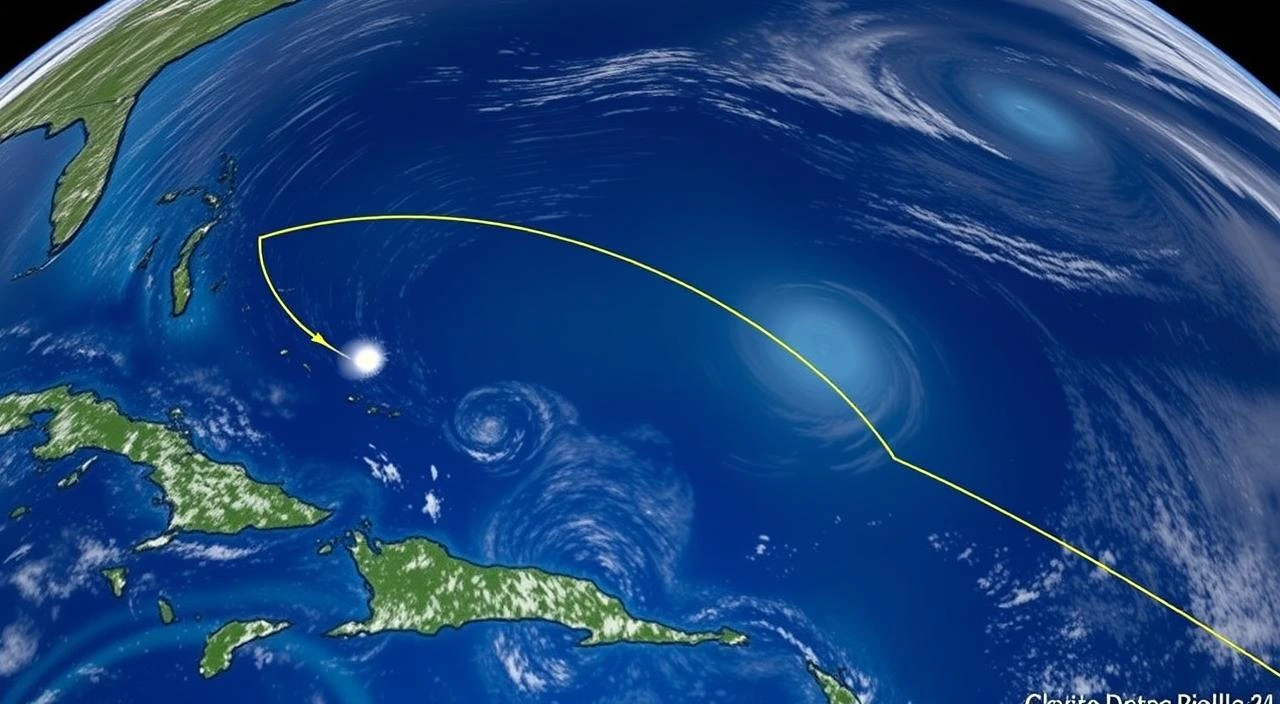Hurricane Nadine is growing stronger and heading straight for Florida’s west coast. Meteorologists are watching Nadine closely. They think it could be one of the worst hurricanes to hit Florida.
As of late Tuesday night, Nadine’s winds reached 160 mph. Its barometric pressure dropped below 900 millibars. This makes Nadine one of the top five most intense Atlantic hurricanes ever.
Nadine’s eye is getting tighter. It’s expected to hit near Sarasota on Wednesday night. The winds will be 111 to 129 mph, making it a major hurricane.
After that, Nadine will move eastward along the Interstate 4 corridor. It will pass south of Orlando before leaving the state’s east coast near Melbourne on Thursday.
Key Takeaways
- Hurricane Nadine is a powerful Category 5 storm with winds up to 160 mph.
- Nadine’s barometric pressure is one of the lowest on record, making it an extremely intense hurricane.
- Nadine is expected to make landfall near Sarasota, Florida, as a major hurricane with winds of 111-129 mph.
- The storm is forecast to track eastward across the densely populated I-4 corridor, posing a significant threat to communities.
- Residents in Nadine’s path should heed all evacuation orders and take necessary precautions to protect their families and property.
Hurricane Nadine’s Intensity and Track
Hurricane Nadine is moving fast across the Gulf of Mexico. Its pressure has dropped below 900 millibars. This makes it one of the top five most intense Atlantic hurricanes on record.
Hurricane hunter aircraft found a huge drop in pressure in Nadine’s eye. This shows Nadine is getting even stronger.
By Tuesday night, Nadine’s pressure hit a record-low of 902 millibars. The storm’s intensity is expected to keep changing as it moves through the Gulf of Mexico. Meteorologists are watching Nadine closely because it’s so unpredictable.
Nadine’s Eyewall Tightening and Northeast Turn
The hurricane’s eyewall is getting tighter, showing Nadine is getting stronger. Experts think Nadine will turn northeast soon. This could affect the Gulf Coast and Florida panhandle.
People in these areas should keep an eye on Nadine’s updates. They should be ready to act if needed.
Nadine’s hurricane nadine intensity, hurricane nadine track, and possible hurricane nadine category increase are big challenges. Knowing the hurricane nadine wind speeds, hurricane nadine pressure, and hurricane nadine fluctuations is key. This info helps with evacuation orders and disaster plans in the hurricane nadine gulf of mexico areas.
Catastrophic Storm Surge and Wind Threat
Hurricane Nadine is heading straight for the Florida coast. People in the area are getting ready for a big hit. The forecast says a storm surge of 12-15 feet could hit Tampa Bay, which the mayor calls “unsurvivable” for those who don’t leave.
Nadine’s winds will get stronger as it hits Florida. This could cause a lot of damage from tropical-storm-force to hurricane-force winds. The central and northern parts of the state might see a lot of wind damage.
Flooding is also a big worry. Much of central Florida could see flash flooding. The storm’s strong winds and chance of tornadoes make it even more dangerous.
- hurricane nadine storm surge
- hurricane nadine wind damage
- hurricane nadine flooding
- hurricane nadine tornadoes
- hurricane nadine impacts
- hurricane nadine destruction
People in Nadine’s path need to listen to evacuation orders and find safety fast. Time is short, and the damage could be huge. Keep up with the latest on Nadine’s path and strength as it gets closer to Florida.
Nadine Hurricane Path
Hurricane Nadine is moving towards Florida’s coast, and everyone is watching its path. The storm’s possible landfall area is from Homosassa Springs to Captiva Island. This could happen late Wednesday.
Nadine is expected to stay a Category 5 storm when it hits land. This means a huge threat to the area. After landfall, Nadine will move east, affecting the Interstate 4 corridor, south of Orlando. It will then leave Florida’s east coast near Melbourne on Thursday.
People on Florida’s Gulf coast are trying to leave quickly. Nadine’s strong winds and storm surge could destroy coastal areas. The storm’s effects will likely reach far beyond where it lands, putting central and eastern Florida at risk.
| Hurricane Nadine Forecast Highlights | Details |
|---|---|
| Landfall Location | West-central Florida coast, Wednesday night |
| Trajectory | East along Interstate 4 corridor, south of Orlando |
| Exit Point | Florida’s east coast near Melbourne, Thursday |
| Intensity | Maintained Category 5 strength at landfall |
| Impact Area | Central and eastern regions of Florida |
As time runs out, Floridians in Nadine’s path must act fast. They need to protect their homes, get important supplies, and move to safer places. The chance to avoid Nadine’s damage is getting smaller and smaller.
Evacuation Orders and Preparation
As Hurricane Nadine heads towards Florida, people need to act fast. The National Hurricane Center has issued a hurricane warning for central Florida. This warning covers the entire area from the Gulf to the Atlantic coasts.
Experts say there’s little time left to evacuate. Those in danger zones are told to “flee or die.” The storm is expected to hit before dawn on Thursday.
Time Running Out to Evacuate
Many cars are already moving north on Interstate 75. People are leaving to avoid the storm. Others are heading south on the same highway to get away from the danger.
Local leaders are working hard to get everyone out before Nadine hits. The storm could bring a devastating storm surge of over 12 feet to Tampa Bay. Everyone is advised to finalize their hurricane survival plans and gather essential emergency supplies quickly.
| Evacuation Zones | Recommended Actions |
|---|---|
| Coastal Areas | Evacuate immediately to avoid life-threatening storm surge |
| Inland Flood Zones | Prepare for possible flash flooding and seek higher ground |
| Low-Lying Neighborhoods | Secure your property and have a plan to shelter in place |
Time is critical. Officials stress the importance of following evacuation orders and acting now. This is to keep everyone safe and protect their loved ones.
Tracking Nadine’s Impacts Across Florida
Hurricane Nadine is quickly heading towards Florida, and people are getting ready for the worst. The storm will likely cause huge storm surges, strong winds, and lots of rain. The Tampa Bay area, which hasn’t seen a hurricane in over a century, is most at risk.
The storm’s effects will be felt everywhere, with possible damage, power cuts, and flooding. Everyone is advised to follow evacuation orders and take steps to protect themselves and their homes.
Preparing for Power Outages and Road Closures
One big worry is the chance of power outages. Some places might not have electricity for days or even weeks. People are told to have backup plans, like generators and batteries, ready.
Also, many roads could become blocked by fallen trees, debris, and water. This could make it hard to get help and access important services. It’s best to stay off the roads and keep an eye on news and official updates for road closure information.
Potential School and Business Closures
As a safety measure, schools and businesses in Nadine’s path are closing. This is to keep everyone safe and give time for preparations. People should check if schools and businesses are closed and make plans for alternative arrangements.
| Impact | Potential Consequences | Preparation Recommendations |
|---|---|---|
| Power Outages | Widespread and long-lasting, some areas may be without power for weeks |
|
| Road Closures | Impassable roads due to fallen trees, debris, and flooding, disrupting rescue and recovery efforts |
|
| School and Business Closures | Temporary closures to ensure safety and allow for necessary preparations |
|
Conclusion
Hurricane Nadine is getting closer to Florida, and people are getting ready for a big storm. It could be one of the worst hurricanes to hit Florida in a long time. The forecast says Nadine will hit as a major hurricane, causing huge storm surges, strong winds, and lots of flooding.
With little time left, officials are telling coastal people to leave now. They need to protect themselves and their homes. The next few days and weeks will be tough as Florida tries to get back on its feet. But right now, keeping everyone safe is the main goal.
The storm will leave a lot of damage behind, but we’ll learn a lot from it. The recovery efforts will show how climate change affects storms. As Floridians face the storm, it’s clear that planning and being ready for disasters is key.
FAQ
Where is Hurricane Nadine currently located?
Hurricane Nadine’s eyewall is tightening. The storm is starting to move northeast over the Gulf of Mexico.
What is the forecast for Hurricane Nadine’s path and intensity?
Nadine is expected to hit Florida’s west coast on Wednesday night. It will be a major hurricane with winds of 111 to 129 mph. After that, it will move east, passing south of Orlando, before leaving Florida’s east coast near Melbourne on Thursday.
How intense is Hurricane Nadine?
Nadine has grown incredibly intense. Its pressure has dropped below 900 millibars. This makes it one of the top five most intense Atlantic hurricanes on record. A hurricane hunter aircraft reported Nadine’s pressure was dropping again, showing another big increase in intensity.
What are the possible impacts of Hurricane Nadine?
Nadine is expected to cause severe storm surge, strong winds, and heavy rain in Florida. This includes the Tampa Bay area, which hasn’t seen a direct hurricane hit in over a century. The storm could cause a lot of damage, power outages, and flooding across the state.
What areas are under evacuation orders?
The area at risk from Nadine goes from Homosassa Springs to Captiva Island. People on Florida’s Gulf coast are leaving early because Nadine is a Category 5 storm. Authorities are telling coastal residents to evacuate now and take steps to protect themselves and their homes.
How much time is left to evacuate?
The hurricane center says there won’t be enough time to evacuate on Wednesday. People are warned to “flee or die” as officials try to get everyone out before Nadine hits.

My name is Jakir, I am a content writer, content creator, I give business, sports, finance, trending news and I have 10 years of experience in this and this is my blog goldennews24.com.










